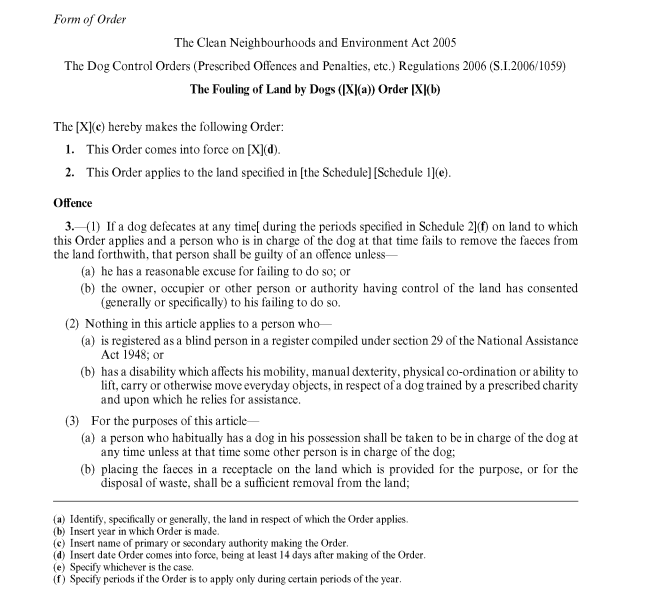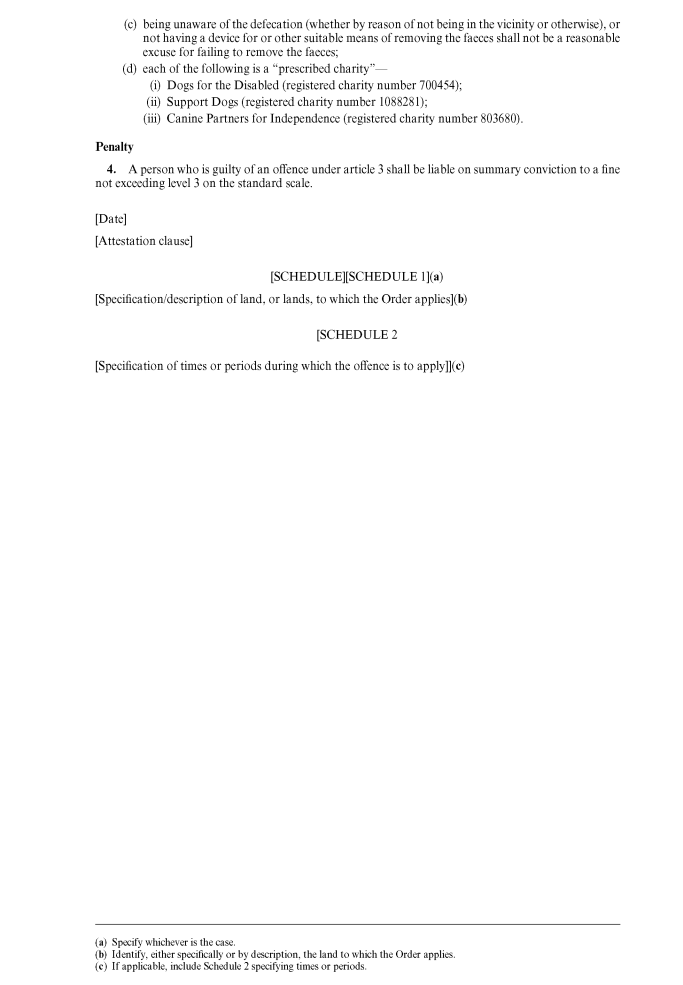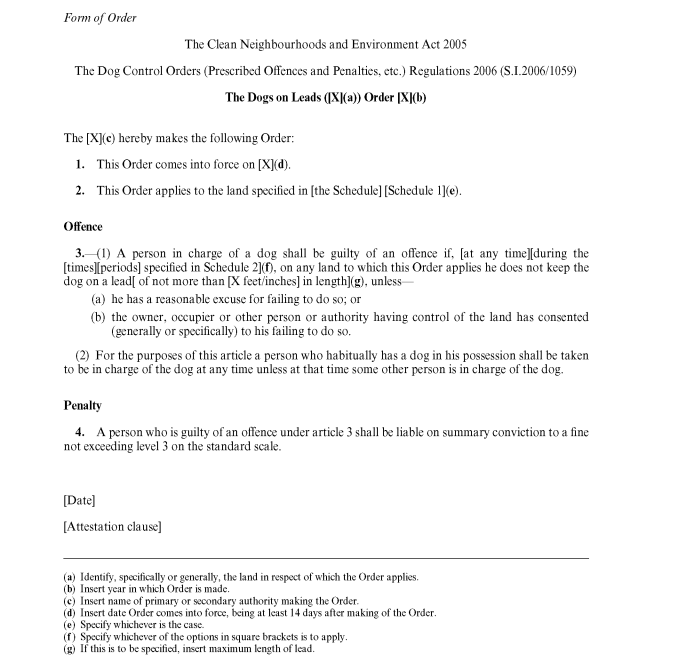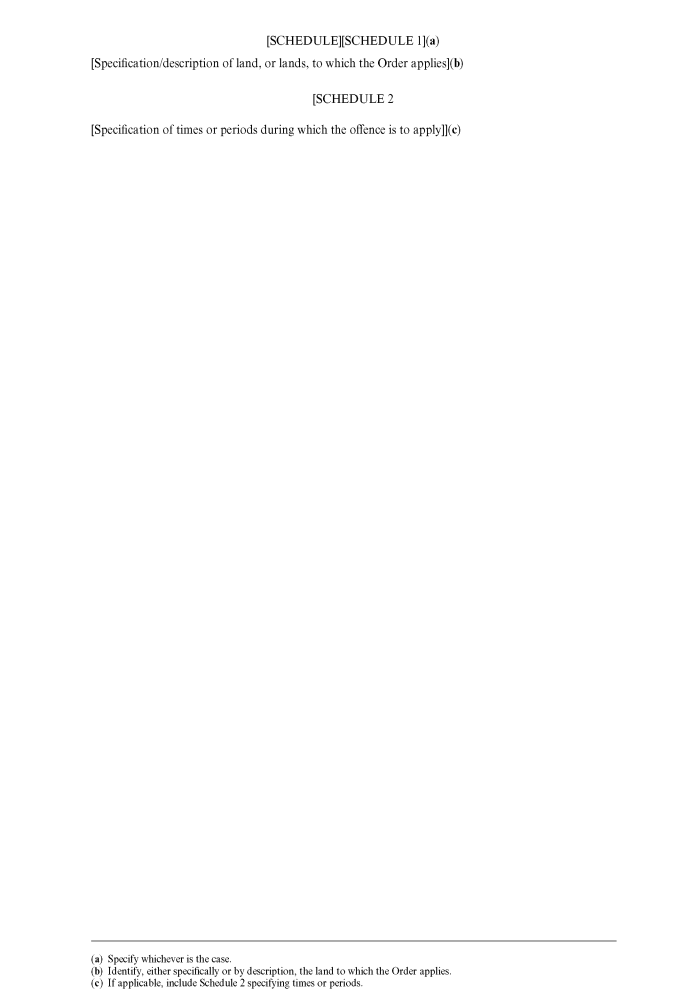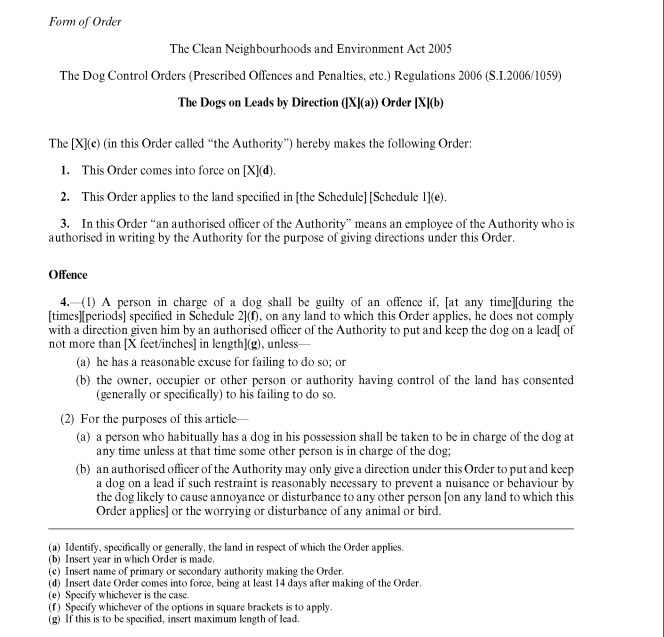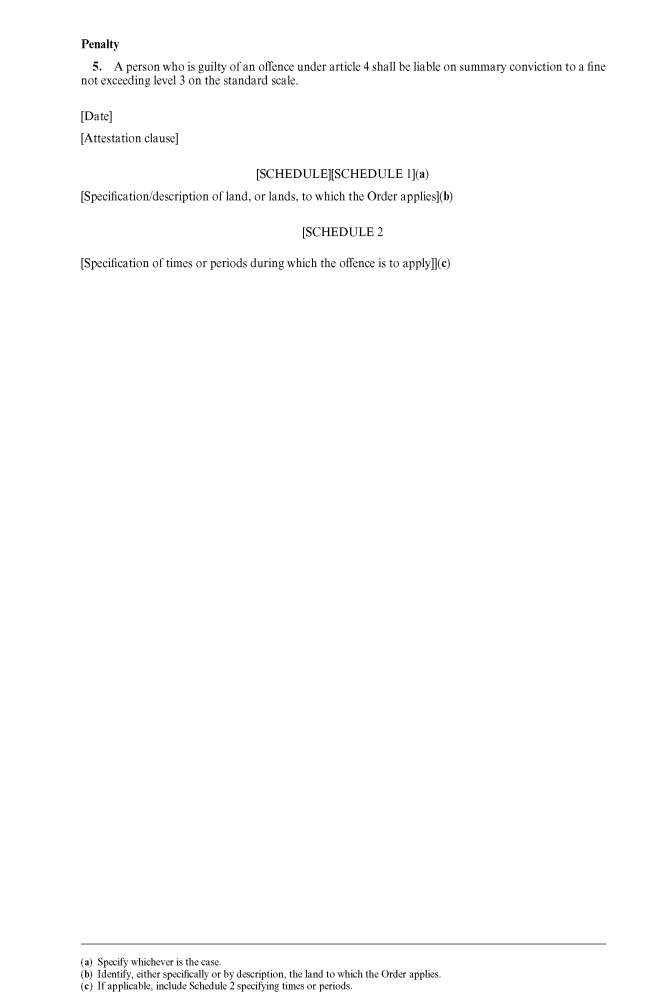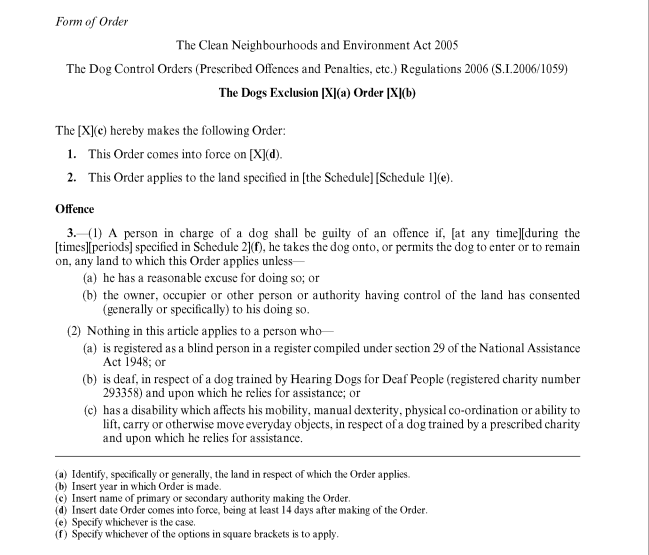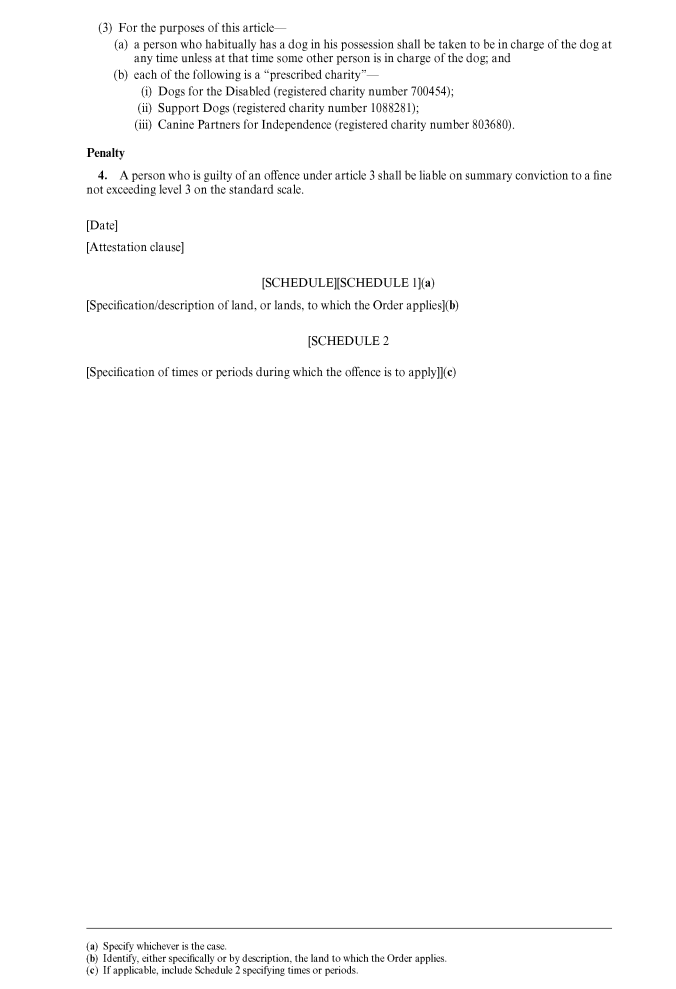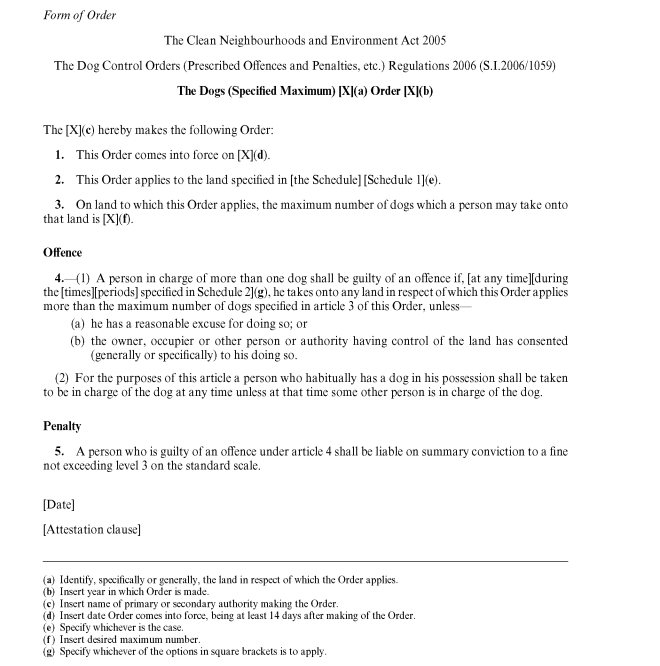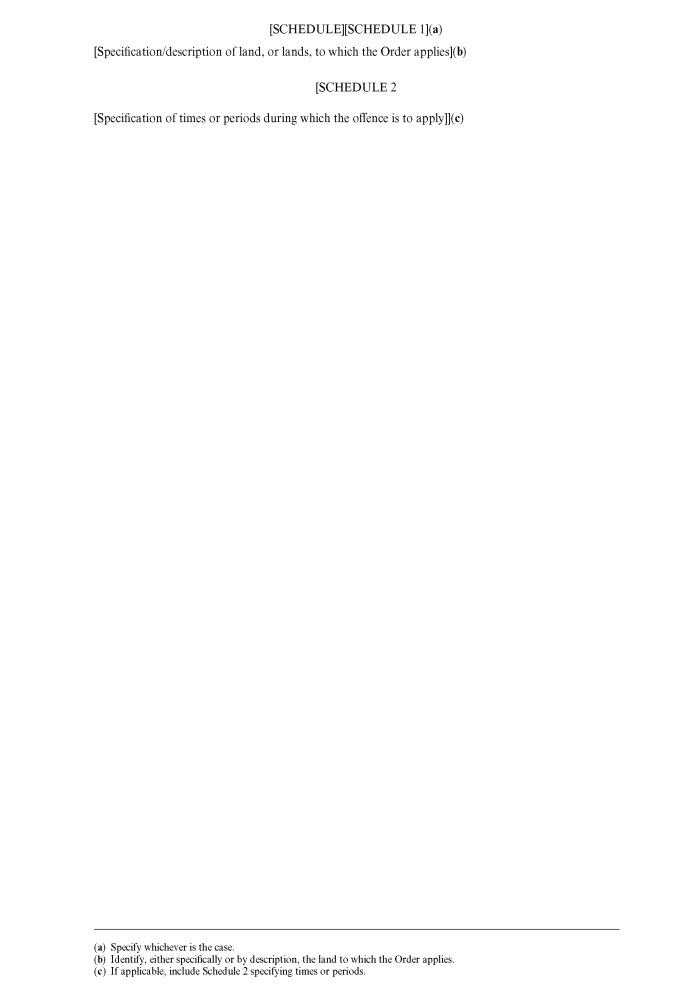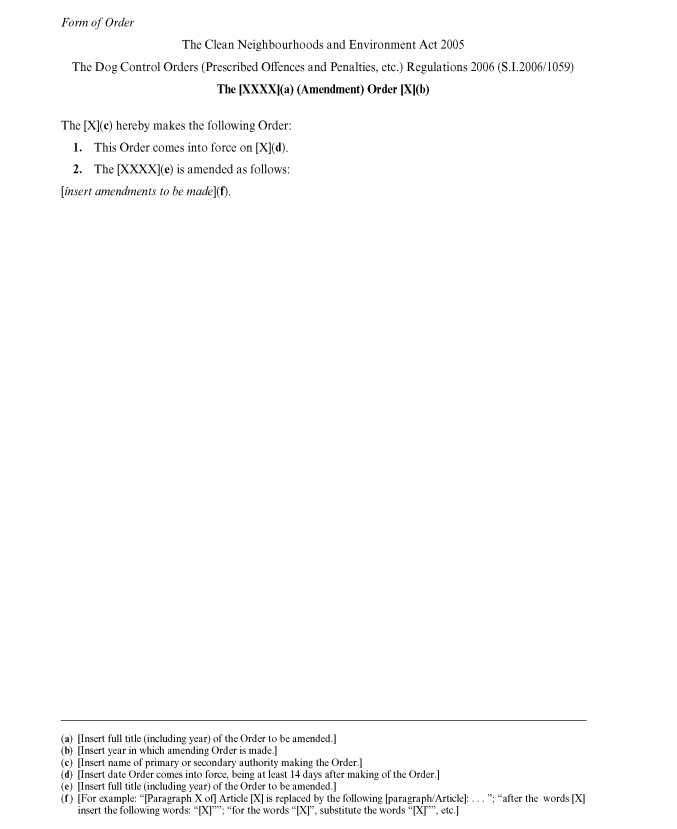Statutory Instruments
2006 No. 1059
DOGS, ENGLAND
CONTROL OF DOGS
The Dog Control Orders (Prescribed Offences and Penalties, etc.) Regulations 2006
Made
5th April 2006
Coming into force in accordance with regulation 1(b)
The Secretary of State, being the appropriate person in relation to England as defined in section 66(a) of the Clean Neighbourhoods and Environment Act 2005(1), makes the following Regulations in exercise of the powers conferred by sections 55(4) and (5), 56(1) and (3) and 67(1) of that Act.
In accordance with section 67(3) of that Act, a draft of this instrument has been laid before Parliament and approved by a resolution of each House of Parliament.
Title, commencement and application
1. These Regulations—
(a)may be cited as the Dog Control Orders (Prescribed Offences and Penalties, etc.) Regulations 2006;
(b)come into force on the day after the day on which they are made;
(c)apply in England only.
Interpretation
2. In these Regulations—
“the Act” means the Clean Neighbourhoods and Environment Act 2005;
an “Authority” means either a primary authority or a secondary authority within the meaning of section 58 (primary and secondary authorities) of the Act.
Prescribed offences and penalties
3.—(1) For the purposes of section 55(4) of the Act, the offences capable of being provided for in a dog control order are those set out in paragraph 1 of each of Schedules 1 to 5.
(2) The penalty to be provided in relation to any offence in a dog control order is, on summary conviction, a fine not exceeding level 3 on the standard scale.
(3) A dog control order may specify the times at which, or the periods during which, an offence is to apply.
Specified wording to be used in, and the form of, a dog control order
4. An Authority which makes a dog control order shall—
(a)in providing for any offence, use the wording specified in the Schedule applying to that offence (under the heading “offence”); and
(b)in all other respects make the order in the form set out in the said Schedule, or in a form substantially to the like effect.
Amendment of a dog control order
5. An Authority which amends a dog control order it has made shall do so in accordance with Schedule 6.
Coming into force of a dog control order
6. The date of coming into force of a dog control order (including an order amending a dog control order) shall be at least 14 days after the date on which the order is made.
Ben Bradshaw
Parliamentary Under Secretary of State
Department for Environment, Food and Rural Affairs
5th April 2006
Regulations 3 and 4
SCHEDULE 1OFFENCE OF FAILING TO REMOVE DOG FAECES and FORM OF ORDER
1.—(1) Subject to sub-paragraphs (2) and (3), it is an offence when being in charge of a dog on land to which a dog control order (described as a “Fouling of Land by Dogs Order” in the form set out below) applies, not to remove faeces deposited by the dog at any time, or at any time during certain periods prescribed in the order.
(2) No offence is committed where a person has a reasonable excuse for failing to remove the faeces, or the owner, occupier or other person or authority having control of the land has consented (generally or specifically) to his failing to do so.
(3) The offence does not apply to a person who is registered as a blind person in a register compiled under section 29 of the National Assistance Act 1948, or to a person who has a disability which affects his mobility, manual dexterity, physical co-ordination or ability to lift, carry or otherwise move everyday objects, in respect of a dog trained by Dogs for the Disabled (registered charity number 700454), Support Dogs (registered charity number 1088281) or Canine Partners for Independence (registered charity number 803680) and upon which he relies for assistance.
2. In any Fouling of Land by Dogs Order, the offence of failing to remove dog faeces is to be set out in full as stated in article 3 in the form of order given below.
3. In all other respects, a Fouling of Land by Dogs Order providing for that offence is to be in the form given below, or in a form substantially to the like effect.
Regulations 3 and 4
SCHEDULE 2OFFENCE OF NOT KEEPING A DOG ON A LEAD and FORM OF ORDER
1.—(1) Subject to sub-paragraph (2), it is an offence when being in charge of a dog on land to which a dog control order (described as a “Dogs on Leads Order” in the form set out below) applies, not to keep the dog on a lead or on a lead of a maximum length prescribed in the order, during such times or periods as may be prescribed.
(2) No offence is committed where a person has a reasonable excuse for failing to keep the dog on a lead, or the owner, occupier or other person or authority having control of the land has consented (generally or specifically) to his failing to do so.
2. In any Dogs on Leads Order, the offence of not keeping a dog on a lead is to be set out in full as stated in article 3 in the form of the order given below.
3. In all other respects, a Dogs on Leads Order providing for that offence is to be in the form given below, or in a form substantially to the like effect.
Regulations 3 and 4
SCHEDULE 3OFFENCE OF NOT PUTTING AND KEEPING A DOG ON A LEAD, UNDER DIRECTION and FORM OF ORDER
1.—(1) Subject to sub-paragraph (2), it is an offence when being in charge of a dog on land to which a dog control order (described as a “Dogs on Leads by Direction Order” in the form set out below) applies, not to put, and thereafter keep, the dog on a lead or on a lead of a maximum length prescribed in the order, during such times or periods as may be prescribed, when directed to do so by an authorised officer of an Authority.
(2) No offence is committed where a person has a reasonable excuse for failing to comply with a direction to put and keep the dog on a lead, or the owner, occupier or other person or authority having control of the land has consented (generally or specifically) to his failing to do so.
2. In any Dogs on Leads by Direction Order, the offence of not putting and keeping a dog on a lead, by direction, is to be set out in full as stated in article 4 in the form of the order given below.
3. In all other respects, a Dogs on Leads by Direction Order providing for that offence is to be in the form given below, or in a form substantially to the like effect.
Regulations 3 and 4
SCHEDULE 4OFFENCE OF PERMITTING A DOG TO ENTER LAND FROM WHICH IT IS EXCLUDED and FORM OF ORDER
1.—(1) Subject to sub-paragraphs (2) and (3), it is an offence when being in charge of a dog on land to which a dog control order (described as a “Dogs Exclusion Order” in the form set out below) applies, during such times or periods as may be specified in the order, to take the dog onto, or to permit it to enter or to remain on, such land.
(2) No offence is committed where a person has a reasonable excuse for taking the dog onto, or permitting it to enter or remain on, the land, or the owner, occupier or other person or authority having control of the land has consented (generally or specifically) to his doing so.
(3) The offence does not apply to a person who is registered as a blind person in a register compiled under section 29 of the National Assistance Act 1948, to a deaf person in respect of a dog trained by Hearing Dogs for Deaf People (registered charity number 293358), or to a person who has a disability which affects his mobility, manual dexterity, physical co-ordination or ability to lift, carry or otherwise move everyday objects, in respect of a dog trained by Dogs for the Disabled (registered charity number 700454), Support Dogs (registered charity number 1088281) or Canine Partners for Independence (registered charity number 803680) and upon which he relies for assistance.
2. In any Dogs Exclusion Order, the offence of taking a dog onto, or permitting it to enter or to remain on, land from which it is excluded is to be set out in full as stated in article 3 in the form of the order given below.
3. In all other respects, a Dogs Exclusion Order providing for that offence is to be in the form given below, or in a form substantially to the like effect.
Regulations 3 and 4
SCHEDULE 5OFFENCE OF TAKING MORE THAN A SPECIFIED NUMBER OF DOGS ONTO LAND and FORM OF ORDER
1.—(1) Subject to sub-paragraph (2), it is an offence when being in charge of more than one dog on land to which a dog control order (described as a “Dogs (Specified Maximum) Order” in the form set out below) applies, during such times or periods as may be specified in the order, to take more than the maximum number of dogs specified in the order onto that land.
(2) No offence is committed where a person has a reasonable excuse for taking more than the specified maximum number of dogs onto the land, or the owner, occupier or other person or authority having control of the land has consented (generally or specifically) to his doing so.
2. In any Dogs (Specified Maximum) Order, the offence of taking more than a specified number of dogs onto land is to be set out in full as stated in article 4 in the form of order given below.
3. In all other respects, a Dogs (Specified Maximum) Order providing for that offence is to be in the form given below, or in a form substantially to the like effect.
Regulation 5
SCHEDULE 6FORM OF ORDER AMENDING A DOG CONTROL ORDER
1. An order amending a dog control order shall be in the form given below, or in a form substantially to the like effect.
2. Where the amendment is to the description of an offence, the amendment shall be made by substituting the entire article which sets out the offence, and the substituted article shall set out the offence as it is required to be stated were it contained in a newly made dog control order.
Explanatory Note
(This note is not part of the Regulations)
These Regulations, which apply in England, come into force on 6th April 2006.
Further to Chapter 1 (control of dogs) of Part 6 (in particular, sections 55 to 58) of the Clean Neighbourhoods and Environment Act 2005 (c. 16) (“the Act”), under which certain authorities are empowered to make dog control orders, these Regulations prescribe for the purposes of section 55 of the Act the offences that may be provided for in any such order (regulation 3(1) and Schedules 1 to 5).
The offences are:
(a)failing to remove faeces deposited by a dog on land in respect of which a Fouling of Land by Dogs Order applies (Schedule 1, paragraph 1);
(b)failing to keep a dog on a lead on land in respect of which a Dogs on Leads Order applies (Schedule 2, paragraph 1);
(c)failing to put, and to keep, a dog on a lead, when directed to do so by an authorised officer, on land in respect of which a Dogs on Leads by Direction Order applies (Schedule 3, paragraph 1);
(d)permitting a dog to enter land in respect of which a Dogs Exclusion Order applies (Schedule 4, paragraph 1); and
(e)taking more than the maximum number of dogs onto land in respect of which a Dogs (Specified Maximum) Order applies (Schedule 5, paragraph 1),
in each case without reasonable excuse or without the consent of the owner, occupier or other person or authority who has control of the land. The offences of failing to remove dog faeces and of permitting a dog to enter land from which dogs are excluded do not apply to a person who is registered as a blind person or to a person who has a disability in respect of which he relies on the assistance of a dog trained by a specified charity; the offence of permitting a dog to enter land from which dogs are excluded also does not apply to a person who is deaf in respect of a dog trained by a specified charity.
The Regulations also prescribe, in fulfilment of the requirement in section 56(1) of the Act, the maximum penalty which may be provided for in a dog control order (regulation 3(2)); this shall be, on summary conviction, a fine not exceeding level 3 on the standard scale (that is, at the time of making these Regulations, £1,000).
In respect of the content and form of a dog control order, the Regulations specify the wording that must be used in providing for an offence in such an order (regulation 4(a), and in paragraph 2 of Schedules 1 to 5), and in all other respects require that a dog control order (including an order amending a dog control order) shall be in the form set out in the appropriate Schedule, or in a form substantially to the like effect as that form (regulation 4(b), and in paragraph 3 of Schedules 1 to 5; in respect of an amending order, regulation 5 and Schedule 6, paragraph 1).
A full regulatory impact assessment of the effect of the then Clean Neighbourhoods and Environment Bill was prepared (dog control orders are dealt with on pp. 58–60), and was deposited in the libraries of both Houses of Parliament; copies of it are available from the Department for Environment, Food and Rural Affairs, Ashdown House, 123 Victoria Street, London SW1E 6DE. A separate regulatory impact assessment has not been produced for these Regulations as they have no impact on the costs of business.
